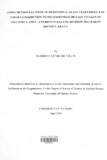| dc.description.abstract | This study was undertaken between March 2003 and June 2003 in Kalama division of
Machakos district to establish the consumption patterns and nutrient contents of
traditional vegetables. A household survey was carried out using a self-administered
structured questionnaire to collect data on demographic characteristics of the population
and production, utilization, preferences, preparation and preservation of the vegetables.
Samples of raw commonly consumed vegetables were collected and cooked in simulated
traditional methods. The raw and cooked vegetables were analysed for reduced ascorbic
acid and beta-carotene. The data was used to calculate the contribution of the vegetables
to the household dietary intakes of the two vitamins in the division.
Results showed that the average household size in Kalama division was 4.9, the female to
male ratio was 100:88, and the dependency ratio was 88. Majority of household heads
were farmers. Literacy levels among the household heads were high, with more than 75%
having some formal education.
The study found that about 16 species of traditional vegetables were consumed in Kalama
division. The highest ranked in terms of preference were Amaranthus spp, Vigna spp, and
Cucurbita maxima in that order. The most common method of preparation was boiling
then mashing the vegetables in a mixture with the staple food, isyo. However, the
vegetables were also prepared for consumption as a side dish, in which case they were
boiled then stewed. The average time for both methods of cooking ranged between 5-80
v
minutes with a mean of about 31 minutes. while the proportion of cooking water ranged
between the amounts retained after washing to 1000ml added per kilogram of vegetables.
During preparation as a side dish, nearly one-third of the respondents drained the
vegetables and discarded the water before stewing.
Preservation of the traditional vegetables was practised by only 8.0% of the respondents
though 17.0% reported consuming them whenever they accessed them, implying that
consumption would be higher if more were availed.
Reduced ascorbic acid contents in the raw vegetables ranged from 78.3 n:g/lOOg in V
unguiculata to 102.3mgll OOgin Erucastrum arabicum. Raw samples of Solanum nigrum
had the highest levels of beta-carotene (6770Jlg/l OOg), while V unguiculata had the
lowest (5028 Jlg/IOOg). The percent beta-carotene retention after cooking was highest in
Solanum nigrum (over 80%) and lowest in Cucurbita maxima (35%). For ascorbic acid,
retention was below fifty percent in all vegetables, with Solanum nigrum having the
highest retention at 48.8% and the lowest being in Cucurbita maxima at 12.5%.
The mean intake of the study population was 944RE/cu/day for vitamin A,
68.8mg/cu/day for vitamin C and 16.2mg/cu/day for iron. For almost half of the study
population, traditional vegetables contributed about 50% of the recommended dietary
intake for all the three micronutrients. Only a third received more than 100% of the RDI
for vitamin A and iron from traditional vegetables.
VI
The study revealed that a diversity of traditional vegetables are grown and consumed in
Kalama division. Consumption of the vegetables would be increased by improving
availability. Hardly any processing or preservation of the vegetables was practised.
despite the prolonged cooking, the contribution of traditional vegetables to dietary intakes
.
of the three micronutrients was high. This implies that this contribution would even be
higher if discarding of cooking water was not practiced at all and cooking time was
shorter.
The contribution of the vegetables to the dietary intake of Vitamins A and C, and iron
was high. Consumption .of the cooking water would definitely increase the dietary intake
of the three micronutrients. | en |

